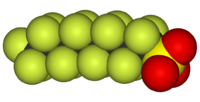
Photo from wikipedia
Abstract PFASs are a class of compounds that include perfluoroalkyl and polyfluoroalkyl substances, some of the most persistent pollutants still allowed ‐ or only partially restricted ‐ in several product… Click to show full abstract
Abstract PFASs are a class of compounds that include perfluoroalkyl and polyfluoroalkyl substances, some of the most persistent pollutants still allowed ‐ or only partially restricted ‐ in several product fabrications and industrial applications worldwide. PFASs have been shown to interact with blood proteins and are suspected of causing a number of pathological responses, including cancer. Given this threat to living organisms, we carried out a broad review of possible sources of PFASs and their potential accumulation in agricultural plants, from where they can transfer to humans through the food chain. Analysis of the literature indicates a direct correlation between PFAS concentrations in soil and bioaccumulation in plants. Furthermore, plant uptake largely changes with chain length, functional group, plant species and organ. Low accumulations of perfluorooctanoic acid (PFOA) and perfluorooctane sulfonic acid (PFOS) have been found in peeled potatoes and cereal seeds, while short‐chain compounds can accumulate at high levels in leafy vegetables and fruits. Significant variations in PFAS buildup in plants according to soil amendment are also found, suggesting a particular interaction with soil organic matter. Here, we identify a series of challenges that PFASs pose to the development of a safe agriculture for future generations. HighlightsMain sources of PFASs for plants are polluted water and biosolids.Content and type of soil organic matter affect plant uptake of PFASs.Extent of PFAS accumulation depends on their chain length and functional groups.Sulfonated PFASs are commonly less taken up than those with carboxylic groups and the same number of carbon atoms.Leaf of cereals and vegetables can accumulate high levels of short‐chain PFASs.
Journal Title: Environmental Research
Year Published: 2019
Link to full text (if available)
Share on Social Media: Sign Up to like & get
recommendations!